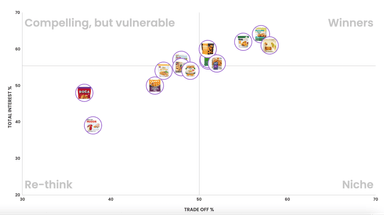In our last post, we talked about why innovation is hard to nail. We told the story of Heinz and how even the longest-standing brands craft innovation strategies that fail (see: EZ Squirt). This time, we want to show how you can make sure that you don’t make the same mistakes as Heinz or other famous brands that tried to do something different. We think building an effective innovation pipeline is the answer. Here’s how you do it!
1. Understand different types of portfolio innovation:
Before a business dives into the innovation process, every team needs to understand all the different types of innovation. This will help them put their ideas in the context of their specific portfolio and set the right performance metrics for each project.
McKinsey identifies four types of innovations that any innovator needs to know:
Line extension is the safest option for brands that want to innovate within the existing category by developing a variation of a product; think of the different flavours of Oreo cookies.
Innovation expansion is when a business creates a new product within current categories or markets; for instance when the oat producer Quakers entered the plant-based milk space.
Disruptive innovation occurs when a brand launches innovation in a new market; those are the Ubers and Airbnb’s of the category.
Renovation is when a brand improves its product, packaging or positioning; for example, back in 2006, Frito Lay reduced the amount of saturated fats in their potato chip brands by switching to sunflower oil.
Each of these types of innovation has its benefits and drawbacks. However, defining which type of innovation your business undertakes will help a brand plan out their innovation strategy both for short and long-term portfolio growth.
2. Brainstorm ideas to fill your innovation pipeline
Once you’ve got your head around the type of innovation you’re doing, it’s time to jot down all the ideas that come to mind. Don't think about achieving a certain number of ideas. First, consider where you want to get your ideas from.
Desk research and team brainstorming sessions are your friends here. But where should you begin?
We’ve compiled a list of sources of inspiration for your own innovation research purposes:
Consumer data
A successful business today thinks of the consumer first. So in an ideal world, product innovation should start by connecting with your customer.
Some of the ways you can gather valuable consumer insights include conducting customer surveys using DIY survey platforms, running interviews with focus groups, or looking up the past internal consumer data. Companies can go as far as involving their target audience in the brainstorming process, just like Lay’s did when they were looking for more flavour ideas for their potato chips.
It’s worth noting that listening to your target audiences’ needs shouldn’t stop at the early stages of innovation. You should continually keep track of how your audience reacts to your final idea and test their user experience with product prototypes to make better decisions.
Past successes and failures
Many ideas succeed and you can build on that success by optimizing your product even further. But most of the time, ideas aren’t quite right the first time. But that doesn’t mean that they don’t have the potential to get better! Drucker notes that oftentimes failures can become great innovation opportunities because they can open up new pathways (even if the initial attempt didn’t succeed).
James Dyson tested 5,271 prototypes before he finally created his first vacuum cleaner and launched his own company in 1993, which became a worldwide sensation. His journey shows that coming back to old ideas and finding ways to improve them can help your business launch something remarkable.
Employees
Your employees know your product and industry the best, so they can be a great source of idea generation. Encourage them to submit proposals by conducting interviews, setting up brainstorming sessions or even launching a company-wide innovation initiative.
These initiatives can include any employees - they don’t have to be limited to customer service or product development teams. For instance, your engineering and operations folks can bring equally great ideas as your salespeople and CEOs.
Suppliers and business partners
Firms that fall into the company’s value chain can help you innovate because they know your business, your customers and your customers’ needs. Partners and suppliers that have been collaborating with the brand for a long time are very qualified to contribute to the innovation efforts; they’re likely most familiar with your business’s long-term strategy and goals.
Market trends
The market changes regularly, and it’s essential to have your finger on the pulse to predict what’s going to happen next. Whether it’s a major global event like the pandemic, or incremental trends like the gradual adoption of plant-based food products, being aware of what’s happening in the industry will help you tailor your innovations to suit the landscape.
Competitive research
Finally, have a look at your competition.
Is there a new product they’ve just launched? Are they entering new markets? Is there an innovative startup that is approaching the sector differently? Competitor research will help you answer those questions.
Attend industry conferences, sign up to competitive research software like Crayon or Klue, or connect with experts at trade shows and on LinkedIn to get a better sense of the competition.
3. Collect and sort ideas
So you’ve got a heap of ideas, but how might they impact the business?
It’s best to create some sort of criteria to compare your ideas against. That criteria can related to things like:
The impact of the idea on the market or customer behaviour
The feasibility of producing the idea
The time and money required to produce the idea
How new and different the idea is, as compared to the market
Every business is unique, but the above are good starting points.
It’s also useful at this point to rely on a foundational piece of research to cross-examine the potential of your idea(s). If you’ve recently run a usage and attitudes (U&A) study, you’ll have that to rely on. If not, try to get your hands on quantifiable data that speaks to the size of the prize or your target audience’s motivations, preferences, and behaviours.
For anyone new to research, a U&A study offers up an understanding of buying patterns, preferences and motivations within your category amongst your target audience. Being able to compare and contrast your ideas against this research will ensure you’re placing sound bets.
4. Screen and prioritize ideas for your innovation pipeline (idea screening)
Whether you’ve got 5 or 50 ideas at this point, it’s time to put them to a test. Here’s where idea screening comes into place.
Idea screening is a process of assessing ideas against each other, gathering data about them to make decisions.
The goal of idea screening is to examine the viability of the innovation in the real world - before it’s launched. This helps companies reduce the risk of failure, speed up the product development process, and save time and money in the process.
Companies can tailor their questions to project needs and test a variety of ideas against each other to see what rises to the top. Upsiide is used for this exact reason - with powerful reporting that shows you exactly where the highest potential for successful innovation in the market lies. Learn more here.

Creating an innovation pipeline might seem like a daunting task…
... until you actually start looking at the steps we’ve outlined above one-by-one. In the end, it’s all logic. And it becomes iterative, helping you and your team discover unique ideas from your key stakeholders and employees.




